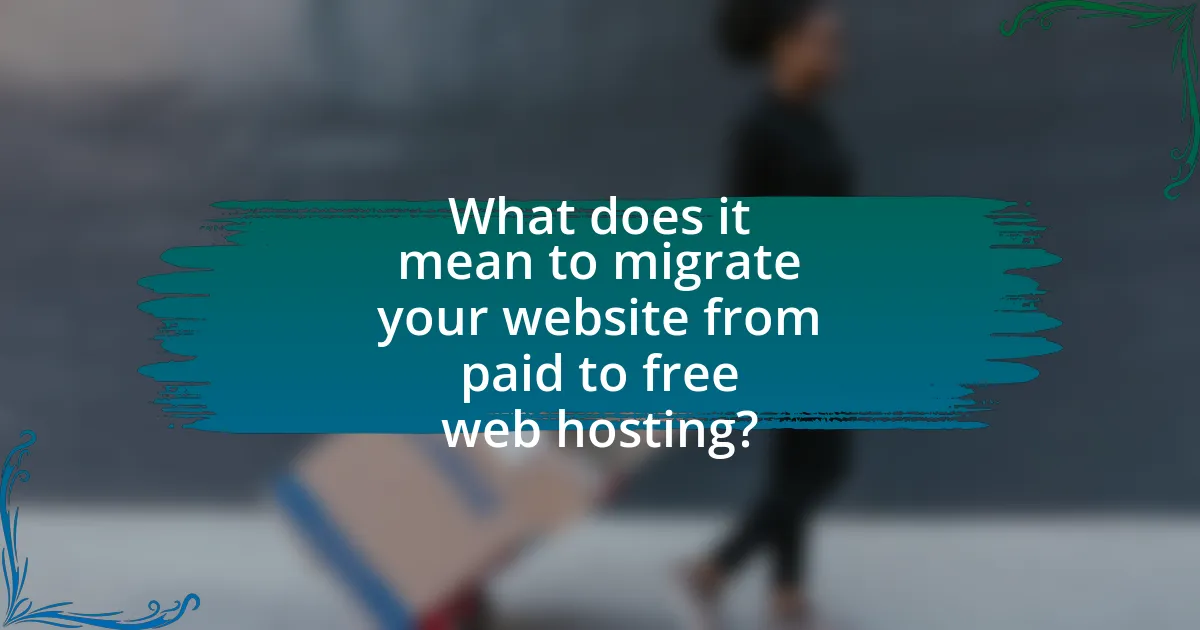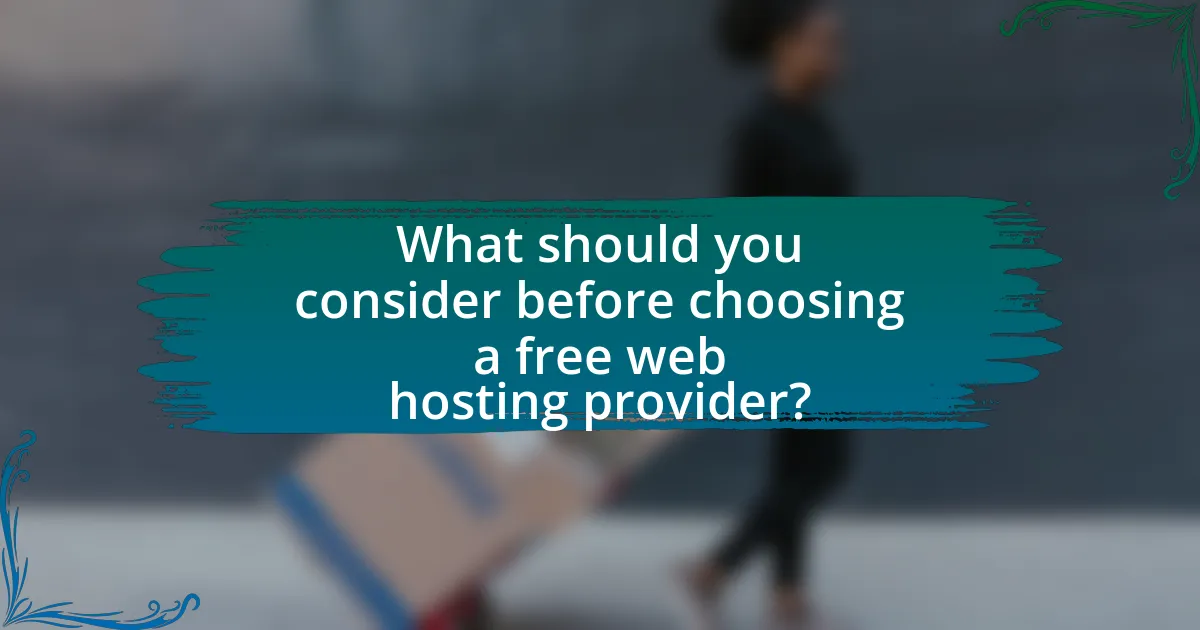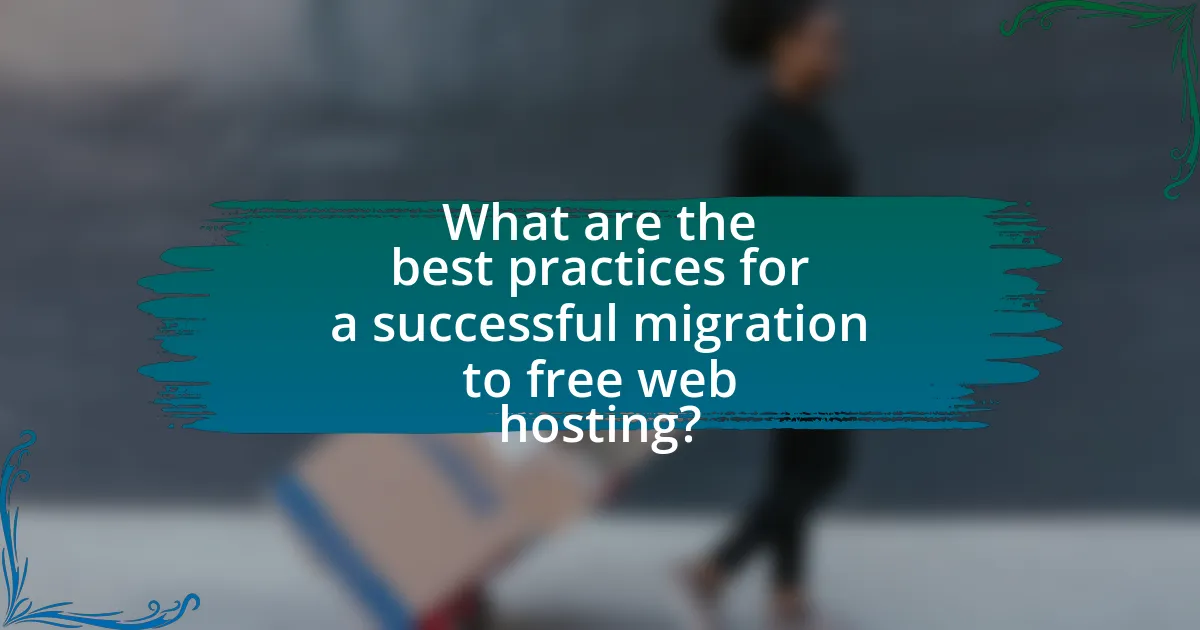Migrating a website from paid to free web hosting involves transferring files, databases, and configurations to a free hosting service, which can significantly reduce costs for individuals and small businesses. This process includes backing up data, selecting a suitable free provider, and addressing potential challenges such as data loss and downtime. While free hosting offers essential features, it often comes with limitations like reduced storage and bandwidth, which can impact performance and reliability. Key considerations include evaluating the features of different free hosting providers, understanding the importance of customer support, and preparing for potential long-term challenges as the website grows.

What does it mean to migrate your website from paid to free web hosting?
Migrating your website from paid to free web hosting means transferring your website’s files, databases, and configurations from a paid hosting service to a free hosting service. This process typically involves backing up your website data, setting up an account with a free hosting provider, and uploading your website files to the new server. Free web hosting often comes with limitations such as reduced storage, bandwidth restrictions, and fewer features compared to paid services, which can impact website performance and reliability.
Why would someone consider migrating to free web hosting?
Someone might consider migrating to free web hosting primarily to reduce costs associated with website maintenance. Free web hosting services eliminate monthly fees, making them attractive for individuals or small businesses with limited budgets. According to a survey by HostingAdvice, 70% of small businesses cite cost as a significant factor in their hosting decisions. Additionally, free hosting can provide essential features such as website builders and basic storage, allowing users to establish an online presence without financial commitment.
What are the potential cost savings of switching to free web hosting?
Switching to free web hosting can lead to significant cost savings, primarily by eliminating monthly or annual hosting fees that typically range from $5 to $100. By opting for free hosting, individuals and small businesses can redirect these funds towards other operational expenses or investments. Additionally, free web hosting often includes basic features that meet the needs of personal projects or small websites, further reducing the necessity for paid services. According to a survey by HostingAdvice, 60% of users reported that cost was the primary factor in choosing free hosting options, highlighting the financial benefits associated with this choice.
How does free web hosting compare to paid options in terms of features?
Free web hosting typically offers limited features compared to paid options. Paid web hosting services generally provide enhanced storage, bandwidth, and performance capabilities, along with additional features such as custom domain names, email accounts, and technical support. For instance, while free hosting may impose restrictions on storage space (often under 1 GB) and bandwidth (limited to a few hundred MB per month), paid plans can offer several terabytes of bandwidth and unlimited storage. Furthermore, free hosting often includes ads on the website, lacks SSL certificates for security, and provides minimal customer support, whereas paid services usually offer 24/7 support and advanced security features. These differences highlight the significant limitations of free web hosting in terms of functionality and reliability.
What challenges might arise during the migration process?
During the migration process from paid to free web hosting, several challenges may arise, including data loss, downtime, and compatibility issues. Data loss can occur if backups are not properly managed, leading to the potential loss of website content and user information. Downtime may result from DNS propagation delays or server configuration errors, which can negatively impact user experience and SEO rankings. Compatibility issues can arise if the free hosting service does not support certain technologies or features used by the website, such as specific programming languages or databases. These challenges highlight the importance of thorough planning and testing during the migration process to ensure a smooth transition.
What are common technical issues faced when migrating to free web hosting?
Common technical issues faced when migrating to free web hosting include limited bandwidth and storage, which can lead to slow website performance or downtime. Additionally, free hosting often lacks customer support, making it difficult to resolve issues quickly. Security vulnerabilities are also prevalent, as free hosts may not provide adequate protection against attacks. Furthermore, compatibility problems can arise due to differences in server configurations, potentially causing website functionality issues. Lastly, the presence of ads on free hosting platforms can detract from the user experience and brand image.
How can downtime be minimized during the migration?
Downtime during migration can be minimized by implementing a phased migration strategy. This approach involves transferring data and services in stages rather than all at once, allowing for testing and adjustments at each phase. Additionally, utilizing a temporary domain or subdomain during the migration can help maintain accessibility, as users can still access the site while the main domain is being updated. According to a study by the Nielsen Norman Group, phased migrations can reduce user disruption by up to 70%, demonstrating the effectiveness of this method in maintaining service continuity.
What steps are involved in the migration process?
The migration process from paid to free web hosting involves several key steps: first, backing up your website data, including files and databases; second, selecting a suitable free web hosting provider that meets your needs; third, transferring your website files to the new hosting environment; fourth, updating your domain’s DNS settings to point to the new host; and finally, testing your website to ensure it functions correctly on the new platform. Each of these steps is essential to ensure a smooth transition and minimize downtime.
How do you prepare your website for migration?
To prepare your website for migration, first, conduct a comprehensive backup of all website files and databases. This ensures that you have a complete copy of your site in case of any issues during the migration process. Additionally, you should document your current website structure, including URLs, content, and any specific configurations, to facilitate a smooth transition. It is also essential to test the new hosting environment for compatibility with your website’s technologies, such as PHP versions and database support. Finally, update your DNS settings to point to the new hosting provider after confirming that the new site is functioning correctly. These steps are critical to minimize downtime and data loss during the migration.
What tools can assist in the migration from paid to free hosting?
Tools that can assist in the migration from paid to free hosting include website migration plugins, FTP clients, and backup services. Website migration plugins like Duplicator and All-in-One WP Migration simplify the process by automating the transfer of files and databases. FTP clients such as FileZilla allow users to manually transfer files between servers, ensuring all content is moved accurately. Backup services like UpdraftPlus enable users to create complete backups of their websites, which can then be restored on the new free hosting platform. These tools are widely used and recommended for their effectiveness in facilitating smooth transitions between hosting services.

What should you consider before choosing a free web hosting provider?
Before choosing a free web hosting provider, you should consider the limitations on resources such as bandwidth, storage, and support. Many free hosting services impose strict caps on these resources, which can hinder your website’s performance and accessibility. For instance, a study by HostingAdvice found that 70% of free hosting providers limit bandwidth to less than 1GB per month, which is insufficient for most websites. Additionally, the lack of customer support can lead to prolonged downtime, as many free services do not offer reliable assistance. Therefore, evaluating these factors is crucial to ensure that the free hosting provider meets your website’s needs effectively.
What are the key features to look for in a free web hosting service?
Key features to look for in a free web hosting service include storage space, bandwidth, uptime reliability, customer support, and ease of use. Storage space determines how much data you can host, while bandwidth affects the amount of traffic your site can handle. Uptime reliability is crucial, as a service with 99.9% uptime ensures your website remains accessible. Customer support is important for resolving issues, and ease of use allows for straightforward website management. According to a 2021 survey by HostingAdvice, 70% of users prioritize uptime and support when selecting a hosting service, highlighting the significance of these features.
How important is customer support in a free web hosting service?
Customer support is crucial in a free web hosting service because it directly impacts user experience and problem resolution. Users of free hosting services often encounter technical issues, and effective customer support can significantly reduce downtime and frustration. According to a survey by the Customer Service Institute, 70% of customers are willing to pay more for better service, highlighting the value placed on support. In the context of free web hosting, where resources may be limited, responsive customer support can differentiate a service and enhance user satisfaction, making it a vital component for success.
What limitations should you be aware of with free web hosting?
Free web hosting has several limitations, including restricted storage space, limited bandwidth, and lack of customer support. These constraints can hinder website performance and scalability, as many free hosting services offer only a few hundred megabytes of storage and minimal monthly data transfer, which may not accommodate growing traffic. Additionally, free web hosting often includes mandatory advertisements, which can detract from the user experience and brand image. Security features are typically minimal, increasing vulnerability to cyber threats. According to a study by HostingAdvice, 70% of free hosting services do not provide SSL certificates, which are essential for secure data transmission.
How do different free web hosting providers compare?
Different free web hosting providers vary significantly in terms of features, limitations, and user experience. For instance, providers like InfinityFree and 000webhost offer unlimited disk space and bandwidth, while others like Freehostia impose stricter limits on storage and monthly traffic. Additionally, some platforms, such as WordPress.com, provide a user-friendly interface and built-in tools for website creation, but restrict customization options unless users upgrade to a paid plan. Security features also differ; for example, InfinityFree includes free SSL certificates, enhancing site security, whereas other providers may lack this essential feature. Overall, the comparison highlights that while free web hosting can be a viable option for basic needs, the specific offerings and constraints of each provider can greatly influence the user experience and functionality of the hosted website.
What are the most popular free web hosting providers available?
The most popular free web hosting providers available are InfinityFree, 000webhost, and Freehostia. InfinityFree offers unlimited disk space and bandwidth, making it a favored choice among users. 000webhost provides a user-friendly interface and a free plan with 1 GB of disk space and 10 GB of bandwidth, which is suitable for small websites. Freehostia stands out with its unique clustering technology, offering 250 MB of disk space and 6 GB of monthly bandwidth. These providers are widely recognized for their reliability and features in the free web hosting market.
How do user reviews impact the choice of a free web hosting provider?
User reviews significantly influence the choice of a free web hosting provider by providing potential users with insights into the reliability, performance, and customer support of the service. These reviews often highlight real experiences, allowing users to assess the strengths and weaknesses of various providers. For instance, a study by BrightLocal found that 91% of consumers read online reviews, and 84% trust them as much as personal recommendations. This trust in user feedback can lead to increased confidence in selecting a hosting provider that meets specific needs, ultimately guiding users toward options that have been positively reviewed for uptime, speed, and support responsiveness.

What are the best practices for a successful migration to free web hosting?
To successfully migrate to free web hosting, it is essential to conduct thorough research on available free hosting providers to ensure they meet your website’s needs. This includes evaluating factors such as storage limits, bandwidth, uptime reliability, and customer support. Additionally, backing up all website data before migration is crucial to prevent data loss.
After selecting a suitable free hosting provider, transfer your website files and databases carefully, ensuring that all links and functionalities remain intact. Testing the website on the new host before fully switching over is important to identify any issues. Finally, update your domain’s DNS settings to point to the new hosting provider, and monitor the website’s performance post-migration to address any potential problems promptly.
How can you ensure a smooth transition to free web hosting?
To ensure a smooth transition to free web hosting, first, back up all website data, including files and databases, to prevent data loss. This step is crucial as it allows for easy restoration if any issues arise during the migration process. Next, choose a reliable free web hosting provider that meets your website’s requirements, such as bandwidth and storage capacity. Researching user reviews and performance metrics can validate the provider’s reliability. After selecting the provider, carefully follow their setup instructions to configure your new hosting environment, ensuring that all necessary settings, such as domain pointing and DNS configurations, are correctly implemented. Testing the website on the new host before fully switching over can help identify any potential issues. Finally, once everything is functioning correctly, update your domain settings to point to the new free hosting server, completing the transition.
What steps should you take to back up your website before migration?
To back up your website before migration, first, create a complete backup of your website files and database. This involves using a file transfer protocol (FTP) client to download all website files from the server, ensuring that you include all directories and subdirectories. Next, export your database using a tool like phpMyAdmin, which allows you to create a SQL file containing all your database data. This process is crucial because it preserves your website’s content, structure, and functionality. According to industry best practices, maintaining both file and database backups minimizes the risk of data loss during migration, ensuring a smooth transition to the new hosting environment.
How can you test your website after migration to ensure functionality?
To test your website after migration and ensure functionality, conduct a comprehensive review that includes checking all links, forms, and interactive elements. This process involves systematically navigating through each page to verify that all hyperlinks direct to the correct locations, forms submit data as intended, and any dynamic content loads properly. Additionally, utilize tools like Google Search Console to identify crawl errors and ensure that the site is indexed correctly. According to a study by Moz, 70% of users abandon a website that takes more than three seconds to load, highlighting the importance of performance testing post-migration.
What troubleshooting tips can help during and after the migration?
During and after the migration, verifying data integrity is crucial; ensure that all files and databases have been transferred correctly. Use checksums or file comparison tools to confirm that the content matches between the old and new hosting environments. Additionally, monitor website functionality by testing all links, forms, and features to identify any broken elements. Implement error logging to capture any issues that arise post-migration, allowing for quick resolution. Finally, maintain a backup of the original site until the new site is fully operational and verified, providing a safety net in case of unforeseen problems.
How do you resolve common issues that may arise post-migration?
To resolve common issues that may arise post-migration, conduct thorough testing of the website’s functionality, including links, forms, and media. This ensures that all components are working correctly after the transition to free web hosting. Additionally, monitor website performance and loading speeds, as free hosting services may have limitations that affect these aspects. Implementing a backup strategy is crucial; regularly back up the website to prevent data loss in case of unexpected issues. Furthermore, check for any broken links or missing content, as these can occur during migration. Utilizing tools like Google Search Console can help identify and rectify these problems efficiently.
What resources are available for ongoing support after migration?
After migration, resources available for ongoing support include community forums, documentation, and customer support services provided by the free web hosting provider. Community forums allow users to share experiences and solutions, while comprehensive documentation offers guides and troubleshooting tips specific to the hosting platform. Additionally, many free hosting services provide customer support through email or chat, ensuring users can receive assistance with any issues that arise post-migration. These resources collectively enhance user experience and facilitate problem resolution effectively.
What are the long-term considerations after migrating to free web hosting?
Long-term considerations after migrating to free web hosting include limited resources, potential downtime, and lack of customer support. Free hosting services often impose restrictions on bandwidth and storage, which can hinder website performance and scalability as traffic increases. Additionally, these services may experience frequent outages, affecting website availability and user experience. The absence of reliable customer support can complicate troubleshooting and maintenance, leading to prolonged issues. Furthermore, free hosting may come with advertisements that detract from the user experience and brand image. These factors collectively impact the long-term viability and professionalism of a website hosted on a free platform.
How can you monitor the performance of your website on free hosting?
To monitor the performance of your website on free hosting, utilize web analytics tools such as Google Analytics, which provides insights into traffic, user behavior, and site performance metrics. These tools can track page load times, bounce rates, and user engagement, allowing you to assess how well your website is performing. Additionally, you can use website speed testing tools like GTmetrix or Pingdom to measure loading times and identify potential bottlenecks. These tools offer specific metrics that can help you understand the impact of free hosting on your website’s performance, ensuring you can make informed decisions about any necessary optimizations.
What should you do if your website outgrows the free hosting service?
Upgrade to a paid hosting plan if your website outgrows the free hosting service. Free hosting services often have limitations on bandwidth, storage, and features that can hinder your website’s performance and growth. Transitioning to a paid plan provides access to more resources, better customer support, and enhanced security features, which are essential for a growing website. According to a study by HostingAdvice, 70% of websites experience improved loading times and reliability after switching to a paid hosting service, demonstrating the benefits of this upgrade.


